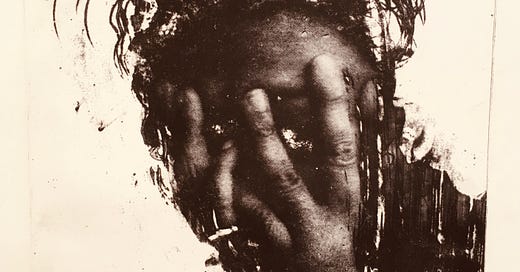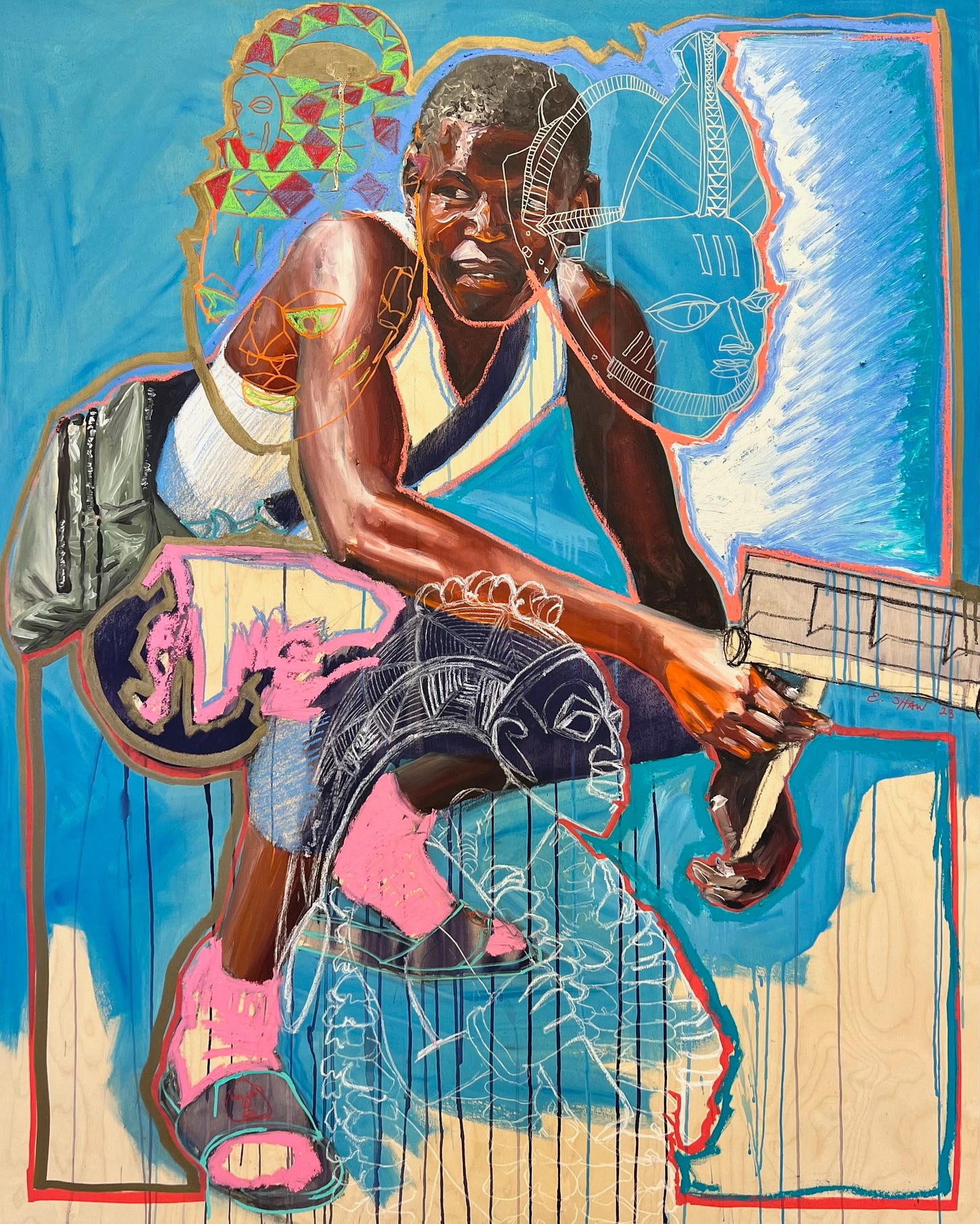FOR ABOUT A DECADE before his death, Michael B. Platt (1948-2019) exhibited intricately textured photo-collages that featured the painted bodies of Australian Aboriginals. This series has been emphasized in posthumous shows of work by the D.C. native, who taught art for more than 30 years at Northern Virginia Community College and more than 10 at Howard University. "Something Left Behind: Selections from the Studio of Michael B. Platt" delves into the earlier years of Platt's career. Not all the pieces selected by curator Gia Harewood bear dates, but most were made between 1969 and 2003.
"Ms. Camella Bell — Atlanta," Michael B. Platt (Courtesy of Brentwood Arts Exchange)
Created before computers redefined Platt's approach, the works on display are primarily drawings and prints. There are also a few paintings, including one executed with dyed paper pulp. On display as well are some items from the artist's studio, among them two African stools, and a poem by Platt's wife and frequent collaborator, Carol A. Beane.
Many of the pictures show Black faces, depicted with empathy and a canny balance of precision and abandon. Platt's gestures are free and muscular, but cohere into details of exceptional realism. Mood trumps representation in such portraits as an extraordinary one of "Ms. Camella Bell — Atlanta," her face in her hands. The light of an eye seems to glisten from between two of her fingers, whose creases and curves appear to be derived from a photograph. The subject's hair and shoulders, however, are rendered loosely. The effect is to suggest one miraculous instant of recognition in a universe that's changing too fast to be apprehended.
Platt took a more traditional approach in his drawing of a 9-year-old Baltimore boy, and the 2003 Washington Post clipping next to the picture explains why. The child was the victim of an arson that killed most of the members of his family. Here the artist took a mechanical wisp of memory -- a halftoned newspaper photo -- of a boy who would never grow up and expanded it into a memorial portrait. It's a delicate tribute, suffused with grief.
Untitled, Michael B. Platt (Courtesy Brentwood Arts Exchange)
In the adjacent gallery, Harewood has curated "Reverberations: The Butterfly Effect of Michael B. Platt," which offers work by 23 artists taught, inspired, or befriended by Platt. Among the highlights are Zoma Wallace's towering fabric assemblage and Winston Harris's large collage-print, suspended so that both of its sides can be seen. Presiding over the selection is Dwight E. Tyler's digital print, "Plattman," a suitably gracious portrait of the honoree.
THE SORROW THAT QUICKENS Platt's drawing of the arson victim echoes in Ernest Shaw's "Movement and Memory," a set of eight mixed-media pictures of Black boys. Half the drawings at Silva Gallery x Latela Curatorial were made atop black-and-white photographs, and two are partially painted. All are vibrant, energetic, and indebted to Pop Art strategies for disrupting representational images. But there's a poignant backstory to the jumpy artworks: They're part of the Baltimore artist's response to the death of his young son, Taj, from cancer.
Untitled, Ernest Shaw (Courtesy Latela Curatorial)
In multi-level compositions, the boys's faces are partly overlaid with sketchy images of African masks, hinting at communal and historical identity. The largest picture illustrates a crouching boy who holds a squeegee for quick washes of car windows, a symbol of inner-city poverty in Baltimore. Yet the ghostly images around and over the boy indicate that he's not just a squeegee kid. Ancient heritage reasserts itself, and bygone traditions ennoble children amid social and economic duress.
Shaw's style reflects what he calls "my lived experience as an Afro-Diasporic man," and his pictures are in part therapeutic. The artist works in Baltimore's public schools, and sees his career, in part, as a way of remaining in contact with his son's spirit. Symbols of the boy join emblems of African culture in the literally and symbolically layered portraits. Each picture depicts an individual person, and a collective experience.
Something Left Behind: Selections from the Studio of Michael B. Platt
Reverberations: The Butterfly Effect of Michael B. Platt
Through Oct. 19 at Brentwood Arts Exchange, 3901 Rhode Island Ave., Brentwood. pgparks.com/facilities/brentwood-arts-exchange. 301-277-2863.
Ernest Shaw: Movement and Memory
Through Oct. 20 at the Silva Gallery x Latela Curatorial, 1630 Columbia Rd. NW. latelacuratorial.com.





